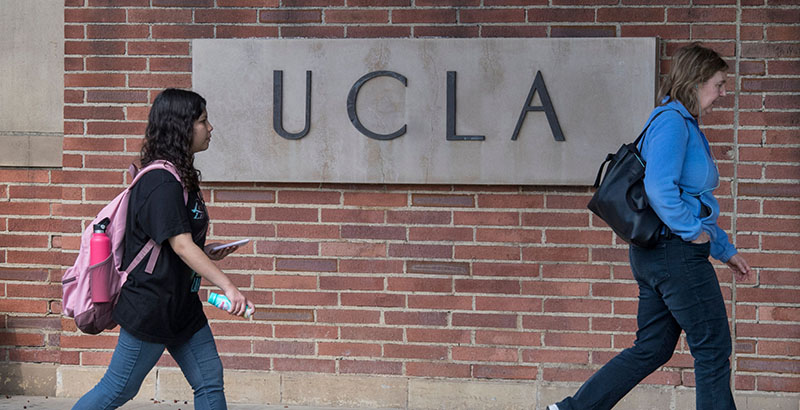Forced to Throw Out Their Old College Admissions Standards, Higher Ed Institutions Should Seize on the Crisis to Create Better Ones for the Future

American higher education has always been enamored with longevity. Student tour guides on campuses across the country tout their institutions’ origin stories, quirky campus traditions and historical successes as they strut backwards past various stately, be-columned buildings with cornerstones announcing their decades — or centuries — of academic tenure.
It’s understandable enough: Many colleges and universities bill themselves as unique clubs with particular characteristics that they’ve developed organically over time. More seriously, the academy has an instinctive reverence for intellectual history; campuses have long served a key role as repositories of human wisdom.
And yet, framing the academic life in terms of links to the past can also create institutional calcification. It can make today’s status quo seem like the only possible way of organizing a campus.
Take colleges’ admissions processes. Several months ago, before the pandemic, California civil rights activists filed suit in an effort to force the system to drop standardized college admission test scores as an admissions requirement. Now, suddenly, unexpectedly, they’ve gotten their wish. Earlier this month, the University of California (UC) system announced that, among other things, its schools would not require students to include standardized test scores with their applications — starting with the 2021 freshman class.
The global coronavirus pandemic is shaking the very foundations of that chunk of the higher education universe. Indeed, public health concerns canceled spring administrations of both the SAT and ACT. For now, UC’s change is temporary, but the system’s size and scope — it enrolls more than 280,000 students across 10 campuses across the state — should open a broader conversation about how to make college admissions fairer. It’s worth asking: If we can do without mandating standardized assessments in college admissions now and the sky doesn’t fall, why bring them back at all?
The UC wouldn’t actually have to blaze a trail. As it happens, my alma mater, Bowdoin College, was the first college in the country to go test-optional (more than 50 years ago). The college has tracked the academic trajectories of students who submit test scores against those who don’t for decades, and it says that it doesn’t find any real impact. (In case it matters: I did submit my scores.) Their findings aren’t unique: When it comes to predicting students’ likelihood of graduating from college, high school grade point averages appear to be significantly better than scores on standardized college admissions assessments. Major university systems in Indiana and North Carolina — part of more than 1,000 test-optional campuses across the country — have followed Bowdoin’s example.
Advocates for making these admissions tests optional also cite studies that flag possible biases in their design. One study has found evidence of bias against African-American test takers in the verbal section of the SAT, arguing that it “favors one ethnic group over another.” There’s also a socioeconomic angle. “The highest predictive value of an SAT isn’t in how well a student will do in school, but how well they were able to avail themselves of prep material,” John A. Pérez, chairman of University of California’s Board of Regents, told the Los Angeles Times last fall. “And access to that prep material is still disproportionately tied to family income.”
At present, there’s ample reason to believe that these assessments have come to serve less as an upward mobility path for historically underserved students and more as an amplifier of existing social inequities. And yet, the tests’ critics shouldn’t overplay their hand (and the research behind it). While college admissions tests have sometimes served as an unfair hurdle for students, particularly those from diverse backgrounds, a good test-optional policy would convert them into an alternative pathway.
“Scores are best used not as the basis for a rank ordering of individuals,” wrote professor Danielle Allen in a 2014 Century Foundation book, “but as thresholds, dividing an applicant pool into those above and those below a line that is roughly predictive of likelihood of success.” That is, they could allow students with lower GPAs to prove their mettle — and earn admission — with higher scores.
What’s more, generally because of inequitable allocation of public education resources, many students from historically underserved communities attend schools that do not offer the full range of advanced coursework and extracurricular activities prized in competitive college admissions. Assessments like the SAT and ACT, however imperfect, could be used to give high-scoring students from under-resourced schools a chance to boost their admissions chances.
Does such a test-optional policy seem impossibly radical? Would it be such an unconscionable departure from college admissions’ meritocratic aspirations? It certainly doesn’t seem so. Suddenly, admissions offices in California are capable of breezing away the core metrics of prestige higher education — things the university system was preparing to defend in court just months ago. Perhaps this status quo was overdue for an update.
Those admissions policies aren’t a pile of natural, set-in-stone definitions of a quality applicant. They’re just the ones we’d gotten accustomed to. As colleges pause on mandating college’s admissions assessments, a decision made for them by the pandemic, it’s an opportunity to think seriously about what’s lost and what would be gained by making this change permanent — not just in our chaotic present, but as part of building a better, fairer future.
Get stories like these delivered straight to your inbox. Sign up for The 74 Newsletter

;)
